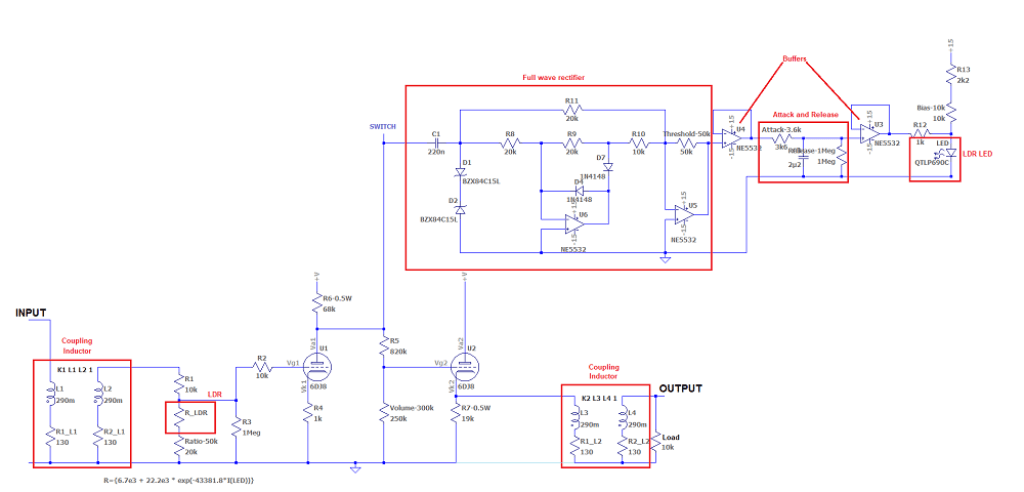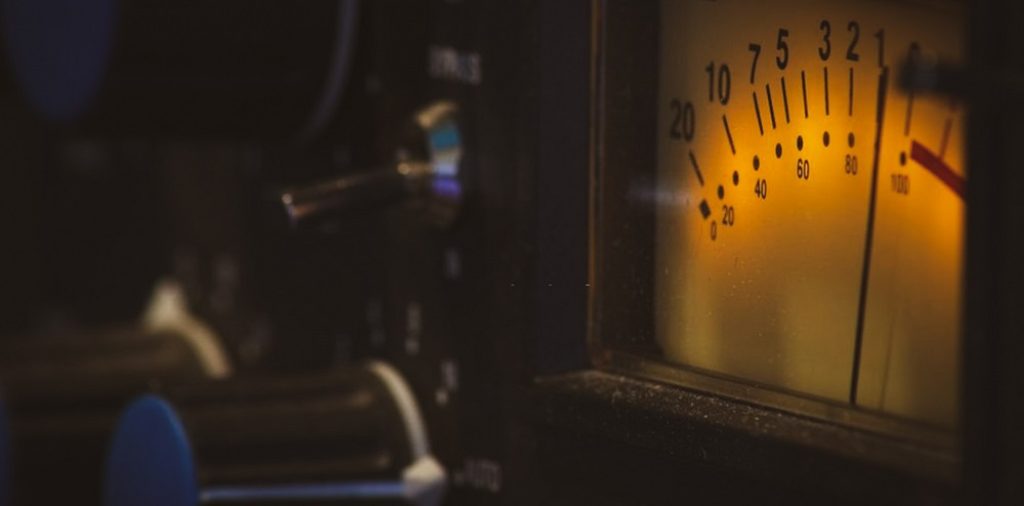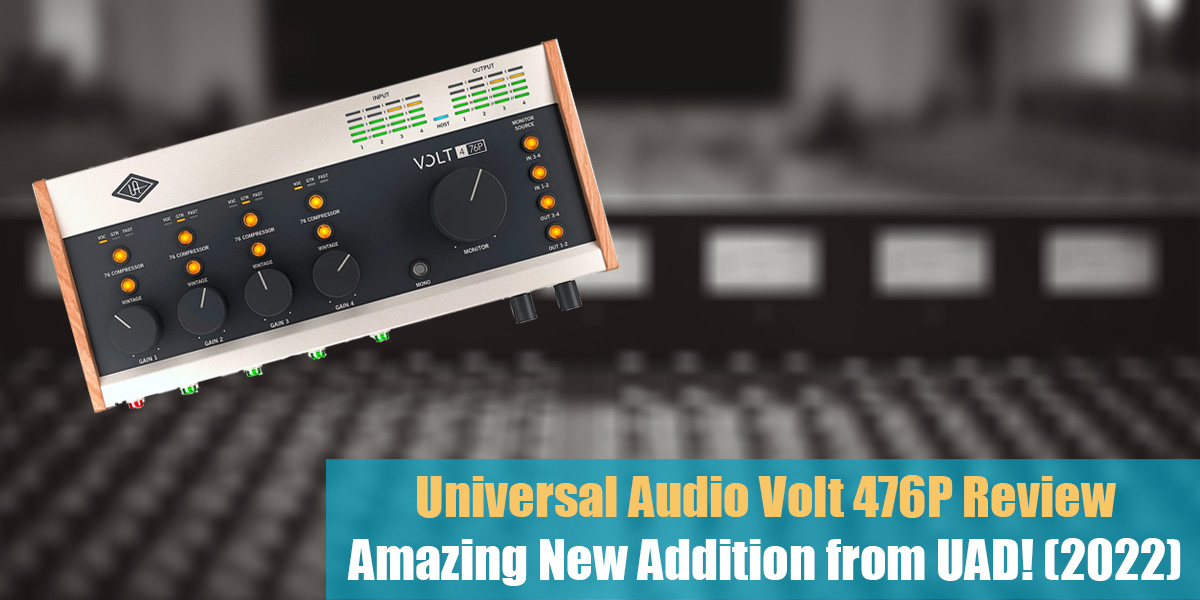What Are Optical Compressors?
Introduction
On our journey to audio mastery, it’s important to understand the optical compressor (or its plugin emulation), as it’s one of the most common types of hardware compressors.
So, how do optical compressors work? An optical compressor shapes the dynamics of an audio signal by using a light element and an optical cell. As the audio signal gets louder, the light element shines brighter, causing the optical cell to reduce the output signal’s volume.
Building an electro-optical attenuator is fairly straightforward. Typically, a compressor splits the incoming audio into two paths: one that passes through the gain stage to become the output, and another that functions as a detector circuit to control the gain. What sets the optical compressor apart is how this detector circuit is constructed.
Gain reduction is managed using a light source paired with a sensor. Thanks to the unique behavior of these components, the gain cell responds in a way that’s been difficult to replicate using traditional electronics until recently.
Much of the magic comes from natural time lags inside the compressor. These result in smooth, musical attack and release characteristics that engineers often prefer over other types of compressors.

An optical compressor can use a standard incandescent light source. However, because of thermal inertia, there is a noticeable delay between when voltage is applied to the filament and when it starts to glow.
You might also use a fluorescent light bulb, but its light intensity does not change consistently with the input voltage. For this reason, most circuits use electroluminescent sources instead.
An electroluminescent source, which is similar to a capacitor, is made from two conductive plates separated by a small gap. It reacts very quickly, allowing for fast attack times in a compressor, and its brightness is directly proportional to the input voltage. This gives predictable attenuation. Some modern designs use a special type of LED for this purpose.
A gain reduction circuit for an optical compressor can, however, use any of these light sources.
- LED stands for light-emitting diode. LEDs are semiconductor devices that emit light when a voltage is applied. In Opto compressors, LEDs are often designed to provide specific characteristics for attack, release, and voltage-to-brightness response.
- A device that uses electroluminescent emission consists of two conductive plates separated by a small gap, much like a capacitor. Electroluminescent devices are known for their fast attack times and the direct proportionality between voltage and brightness.
- A fluorescent bulb is a low-pressure mercury vapor gas discharge lamp that produces light through fluorescence. The relationship between input voltage and brightness in fluorescent bulbs is not linear.
- An incandescent bulb emits light by heating its filament. Due to thermal inertia, there is a slow response time between changes in input voltage and resulting brightness.
What are Opto Compressors Good for?
Opto compressors are well-known for their ability to smooth out audio without reducing transients, helping tracks fit better in the mix with minimal added color.
For example, if you try to control short, sharp transients with a VCA compressor, you might not get the best results. However, an Opto compressor can deliver smooth compression even at higher ratios. This smoother response not only creates a more pleasant sound but also avoids dramatically squashing the signal.
Opto compressors respond best to an RMS signal, so if you’re familiar with the peak and RMS options in your DAW, this will make sense. An RMS display shows the average level of the signal, while a Peak display shows the highest points. Understanding this difference can help you see how an Opto compressor works. While Opto compressors are known for their transparency, they can also add a bit of character to your sound.
Optical audio compressors are commonly used in both recording and live sound to even out the dynamic range of an audio signal and to enhance clarity, sustain, and punch. They’re often used on a variety of instruments—like vocals, drums, and bass—to achieve these effects.

Optical compressors are a great tool to use in the recording studio, whether during tracking, mixing, or even on the mix bus to add overall glue and punch to a mix. Not only do they help control transient-heavy sources like drums and percussion, but they can also bring out the sustain and clarity in vocals and other instruments.
In live sound settings, optical compressors improve clarity and punch by controlling the dynamic range and enhancing the sound of individual instruments in the monitor mix. Using them on vocals is especially popular, as it helps the vocals stand out and be clearly heard in the mix.
A compressor is an essential tool for shaping the dynamics of an audio signal and enhancing the overall sound quality, both in studio recordings and live sound situations.
We want to let you know that our list of the best Opto compressors is in no particular order. They are randomized, as we don’t want to rank them from best to worst.
Here are our Top 5 Opto Compressors of all time:
1. Universal Audio Teletronix LA 2A
The Teletronix LA-2A is famous in its hardware form for delivering gentle, musical compression. Universal Audio offers a plug-in version of the LA-2A in three distinct styles: the highly regarded ‘Silver’ version from the late 1960s, the ‘Gray’ version from the mid-1960s, and the ultra-rare original LA-2 from the early 1960s.
If you don’t already own the original LA-2A plugin, you’ll be glad to know that you’ll also get authorization for the legacy version. This version is still valuable, especially since it uses less DSP power.
The LA-2A couldn’t be more different from the flexible, chameleon-like VCA compressors—this unique character is what sets the hardware Teletronix LA-2A apart.
Its interface is simple, with just two knobs: Peak Reduction, which acts as a threshold control, and Gain, which brings the signal back up to unity after compression. This straightforward setup is all you need to adjust the input and even out the output signal.
In our opinion, this is probably one of the best optical compressors available, and it’s a go-to choice whenever optical compression is needed.
- 0dB to 40dB gain limiting
- Balanced XLR input and output
- Frequency response 30Hz-15kHz (+0/-1dB)
- Output level: 10dBm; Gain: 40dB
- Low noise: 70dB below +10dBm output level
- Handcrafted in UA’s Scotts Valley, California labs

| IMAGE | PRODUCT | For US Customers |
|---|---|---|
Universal Audio Teletronix LA 2A |
2. Heritage Audio Tubesessor Optical Tube Compressor
Heritage Audio has already made a name for itself by creating some fantastic units for studio use, recording, and tracking. We’ve previously reviewed this impressive unit, and now we’d like to share some of what we’ve learned about it.
The Tubesessor is not only perfect for warming up and subtly enhancing a signal while providing full dynamic control, but it also has a few clever features hidden inside its 3U rackmount enclosure.
One of the Tubesessor’s most innovative features is the Tube Saturation knob, which uses a NOS Raytheon CK5755 double triode tube. You can adjust the saturation to four different levels: Classic, Mild, Medium, and Hot.
In addition to the standard controls for threshold (off to -40), ratio (2:1 to 10:1), attack (fast or slow), release (fast or slow), and gain (up to +30dB), there is also a side-chain selector with five options.
- Gain: -10 to +30 dB
- Ratio: 2:1 to 10:1
- Threshold: 10 to -40 dB
- Adjustable output level
- Dimensions (W x H x D): 482 x 134 x 153 mm
- Weight: 3.364 kg

| IMAGE | PRODUCT | For US Customers |
For EU Customers |
Amazon Store |
|---|---|---|---|---|
Heritage Audio Tubesessor |
3. Tube-Tech CL 2A 2-channel Tube Optical Compressor
The Tube-Tech CL 2A Dual Compressor features two independent optical compressors. After the optical gain reduction section, a tube-based output amplifier with +10 dB gain is used, followed by the input transformer.
When using two compressors in stereo mode or linking multiple compressors together, a three-position switch (Link 1, Off, Link 2) is provided. Both link buses are identical.
Both the input and output transformers are fully floating, with a static screen on both sides. The power supply and sidechain signal circuit use solid-state technology. All DC voltages are stabilized except for the anode voltage at the output stage.
This unit is highly sought after by engineers, producers, and artists for its ability to help a track sit well in a mix without losing clarity, no matter how much compression is applied.
Many top rap and hip-hop vocalists use it as their main compressor, but it performs well in any musical setting. It is nearly impossible to get a bad sound from this compressor, and its simple operation makes it a favorite among users.
- Optical gain reduction element
- Channels for linkable stereo operation
- Dual VU meters for indicating output level or compression
- Adjustable output level
- Frequency response: 5 – 60,000 Hz
- Noise-free bypass via relay

| IMAGE | PRODUCT | For US Customers |
For EU Customers |
|---|---|---|---|
Tube-Tech CL 2A 2-channel Tube Optical Compressor |
4. Manley VOXBOX
Although the VOXBOX is primarily known as a channel strip unit, its Opto compression delivers exactly the kind of performance every audio engineer desires. If you’re looking for smooth harmonic distortion, excellent features, and transparent sound, the VOXBOX is the perfect choice.
Beyond being your “last stop” for vocal processing, the Manley Labs VOXBOX is designed to bring out the best in virtually any audio source. It features the same fully-equipped microphone preamplifier as Manley’s acclaimed Mono Microphone Preamplifier, giving you plenty of headroom and the signature warmth of Class A vacuum tubes.
The VOXBOX’s compressor section combines Manley’s best-selling Variable MU technology with their Opto-Design ELOP, resulting in an exceptionally smooth compression experience. On top of that, the VOXBOX offers a Pultec-style mid-frequency equalizer, a de-esser/limiter section, and stereo link capability.
Thanks to Manley’s state-of-the-art design and engineering, you get an incredibly versatile piece of gear. The VOXBOX isn’t just for vocals—it works wonders on instruments like drums, bass, guitars, keyboards, and more. It’s hard to find a better audio processor than the VOXBOX, which has earned a stellar reputation in the audio community worldwide.
- 1-Channel tube preamp with electro-optical compressor
- De-esser/limiter L2A character
- 3-Band tube Pultec EQ
- Transformer-balanced XLR outputs
- VU meter
- +48 V phantom power

| IMAGE | PRODUCT | For US Customers |
For EU Customers |
Amazon Store |
|---|---|---|---|---|
Manley VOXBOX |
5. ART Pro VLA II
The two-channel Pro VLA II comes housed in a 2U rackmount chassis, featuring an elegantly sculpted front panel with two large, backlit analog VU meters.
Below the VU meters, separate LEDs indicate the amount of gain reduction being achieved by the compressor. In addition, LED meters located in the center of the unit display both average and peak output levels, with the peak LED holding its value for a short time.
Both XLR and quarter-inch TRS balanced inputs and outputs are provided, with switchable +4dBu or -10dBu levels to connect to systems operating at either level.
Both inputs and outputs offer enough headroom to handle up to +20dBu when the +4dBu setting is selected. A stereo link button allows the compressor to operate either as two separate mono compressors or as a stereo compressor.
Each channel features small attack and release controls positioned above the threshold, ratio, and output-level knobs. The attack and release settings must always be set manually; there is no automatic mode.
There is also no ‘mix’ or ‘blend’ knob for parallel compression. While this isn’t an essential feature, it’s one we expect to see on more hardware compressors in the near future.
- Adjustable threshold
- Ratio and Attack
- + 4dBu/-10 dBu mode switchable
- Backlit VU meter
- LED meter for peak hold
- Balanced XLR and 6.3 mm inputs and outputs

| IMAGE | PRODUCT | For US Customers |
For EU Customers |
Amazon Store |
|---|---|---|---|---|
ART Pro VLA II |
Conclusion
We’ve covered the basics of how audio signals are processed through Opto compressors and shared some reliable models you can choose from, so you don’t have to worry about picking the right unit.
These days, you’ll also find plenty of audio compressor plugins that emulate the sound and behavior of Opto circuits.
In our humble opinion, Opto compressors remain popular because they’re one of the most well-known types out there. They produce a smooth compressed signal that works especially well with bass frequencies.
If you have any questions about this topic or about the units we mentioned in this article, feel free to ask in the comment section below. We’ll be happy to provide further explanations.






